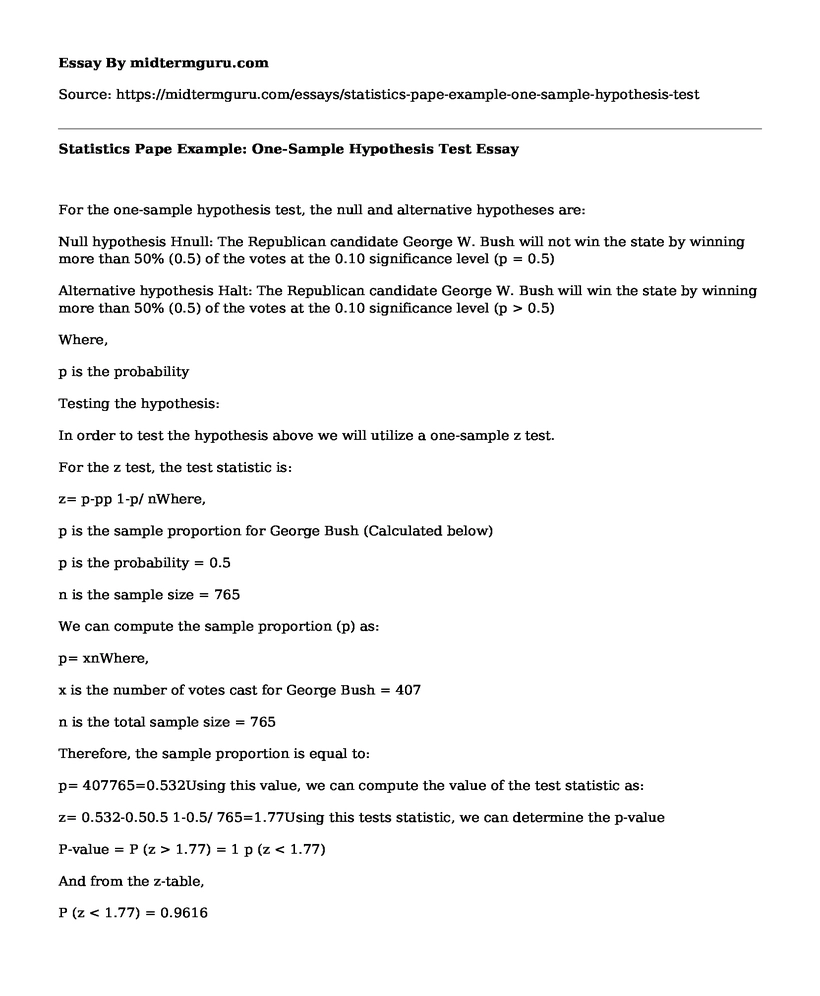For the one-sample hypothesis test, the null and alternative hypotheses are:
Null hypothesis Hnull: The Republican candidate George W. Bush will not win the state by winning more than 50% (0.5) of the votes at the 0.10 significance level (p = 0.5)
Alternative hypothesis Halt: The Republican candidate George W. Bush will win the state by winning more than 50% (0.5) of the votes at the 0.10 significance level (p > 0.5)
Where,
p is the probability
Testing the hypothesis:
In order to test the hypothesis above we will utilize a one-sample z test.
For the z test, the test statistic is:
z= p-pp 1-p/ nWhere,
p is the sample proportion for George Bush (Calculated below)
p is the probability = 0.5
n is the sample size = 765
We can compute the sample proportion (p) as:
p= xnWhere,
x is the number of votes cast for George Bush = 407
n is the total sample size = 765
Therefore, the sample proportion is equal to:
p= 407765=0.532Using this value, we can compute the value of the test statistic as:
z= 0.532-0.50.5 1-0.5/ 765=1.77Using this tests statistic, we can determine the p-value
P-value = P (z > 1.77) = 1 p (z < 1.77)
And from the z-table,
P (z < 1.77) = 0.9616
Therefore,
The p-value = 1 0.9616
= 0.0384
From the results obtained above it is clear that George will win the state by winning more than 50% (0.5) of the votes at the 0.10 significance level (p > 0.5). The main reason for this observation is that Z = 1.77, p = 0.0384. This implies that the z tests results are significant at the 0.1 significance level, therefore, we reject the null hypothesis.
Case Study SpeedX
Hypothesis:
For the one-sample hypothesis test, the null and alternative hypotheses are:
Null hypothesis Hnull: The mean payment period is equal to 22 days at the 0.10 significance level (u = 0.5)
Alternative hypothesis Halt: The mean payment period is less than 22 days at the 0.10 significance level (u < 22)
Where,
u is the population mean
Testing the hypothesis:
In order to test the hypothesis above we will utilize a one-sample z test.
For the z test, the test statistic is:
z= x- us nWhere,
x is the sample proportion
u is the population mean = 22
s is the standard deviation = 6
n is the sample size = 220
We can compute the sample proportion (x) as:
x= xnWhere,
x is the total number of hours = 4759
n is the total sample size = 220
Therefore, the sample proportion is equal to:
x= 4759220=21.63Using this value, we can compute the value of the test statistic as:
z= 21.63-226 / 220=-0.91Using this tests statistic, we can determine the p-value
P-value = P (z < - 0.91)
And from the z-table,
P (z < - 0.91) = 01814
From the results obtained above it is clear that we can fail to reject the null hypothesis. The main reason for this is that the p-value (0.1814) is greater than alpha (0.1) Z = - 0.91, p = 0.1814. This implies that the z tests results are not significant at the 0.1 significance level; therefore, we fail to reject the null hypothesis.
Cite this page
Statistics Pape Example: One-Sample Hypothesis Test. (2021, Jul 02). Retrieved from https://midtermguru.com/essays/statistics-pape-example-one-sample-hypothesis-test
If you are the original author of this essay and no longer wish to have it published on the midtermguru.com website, please click below to request its removal:
- Application for a Job as a Quality Analyst
- Statistics Paper Example on Female Headed Households in Indonesia
- Company Evaluation Paper on T-Mobile
- Workplace Incivility: A Growing Challenge in Our Organization - Essay Sample
- Types of Variables in Research: Categorical & Discrete - Essay Sample
- Qualitative Research: Gathering Factual Data With Research Design - Research Paper
- Research Protocol: Design, Plan, & Ethically Approve - Research Paper







